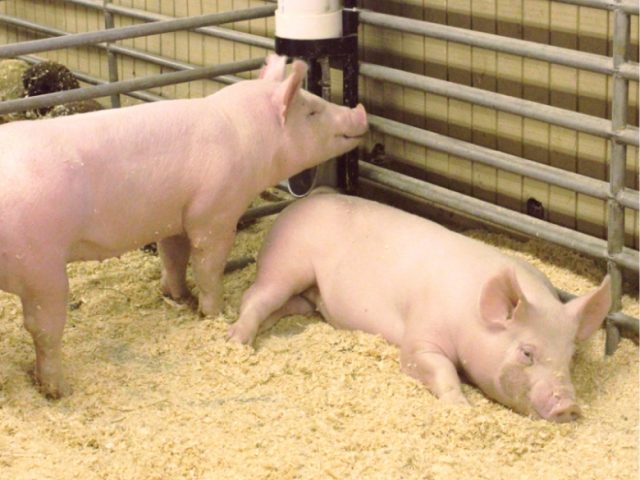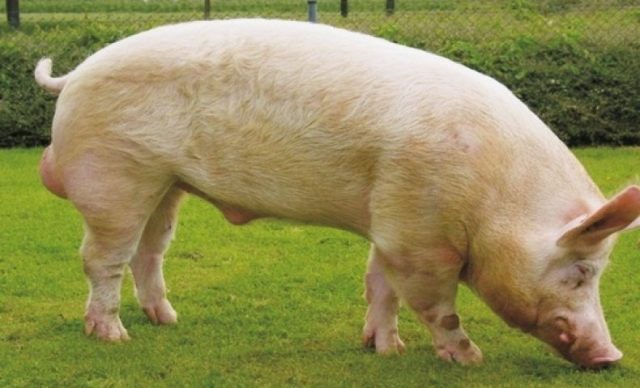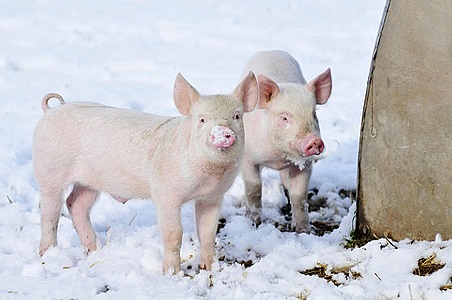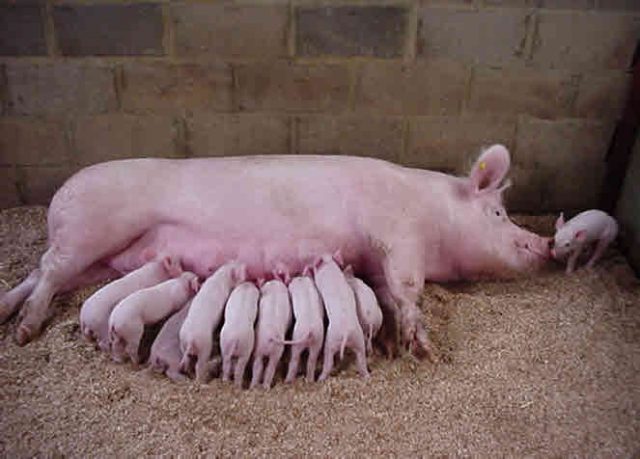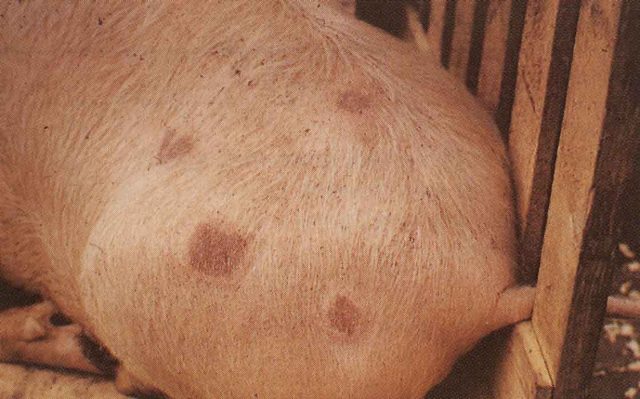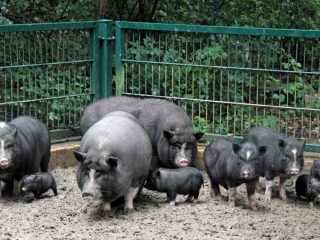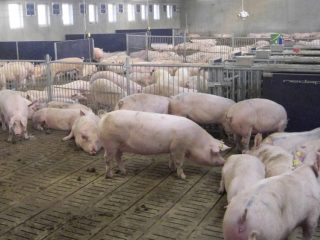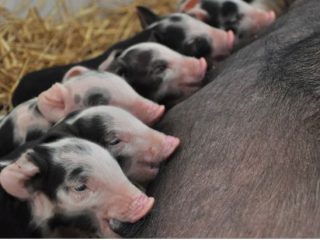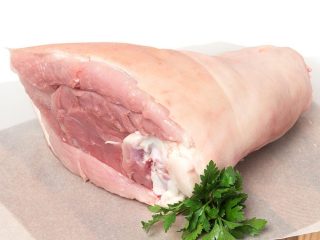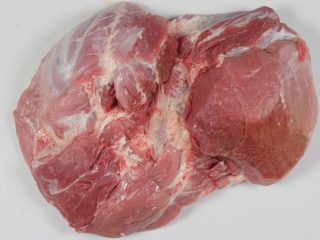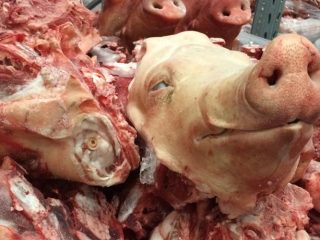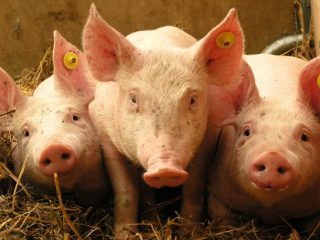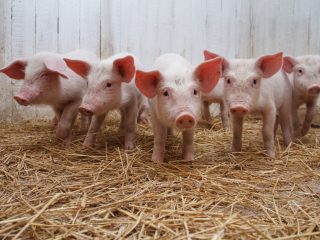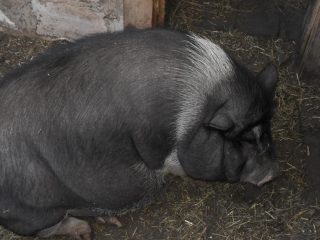Content
Pig breed Yorkshire has been known for several centuries and occupies a leading position in the number of livestock in the world. Premium meat obtained from animals has a “marbled” structure and is highly valued by consumers. The specialized Yorkshire bacon breed is renowned for its fast growing pigs, good fertility and is often used to improve the performance of local herds around the world.
History of breeding
In the mid-19th century, English amateur farmer Joseph Tuley worked to improve the qualities of local breeds by crossing long-eared, Leiter and Chinese white pigs. Trying to combine all the positive qualities, the livestock breeder obtained offspring with precocity of young animals, resistance to diseases and unique fattening properties.
Tuley, through systematic crossing of closely related animals, managed to achieve strengthening and consolidation of useful characteristics, thus obtaining a new breed with unique characteristics.The very appearance of the Yorkshire pigs amazed participants at the annual agricultural exhibition in 1851, where the breed was first introduced to the general public.
With particularly large sizes, the body of a purebred pig is distinguished by its leanness without signs of obesity. Proper maintenance and fattening lead to harmonious weight distribution and uniform, moderate fat deposition. The Yorkshire's body, sleek and toned, was very different from the appearance of other pigs of the time.
Thanks to its high rate of weight gain, ability to adapt to different conditions, and fertility, the breed quickly gained popularity in Britain and spread throughout the world. Tuley's pigs became the name of the county where the amateur pig farmer's livestock farm was located. The farmer, thanks to many years of hard work, received a good fortune, and the species began to be called Yorkshire.
The breed is still considered one of the best and has a universal purpose: special fattening allows you to obtain a large percentage of fat. But the main direction in breeding is lean, tender meat and layer-by-layer distribution of layers of fat and pulp in the product.
Description of Yorkshire pigs
Based on external data, the species is easy to distinguish from others. Characteristics and photos of the Yorkshire pig breed show a large animal weighing up to 350 kg for boars and 250 kg for sows. The cylindrical body reaches a length of 1.8 m. The chest is wide, the stomach is tucked, without sagging. Yorkshires have short, strong legs and large hams.
The back is straight, the shoulders are powerful, the spine is slightly arched in front of the sacrum. The head is small with a wide forehead. The ears are protruding, pointing upward and slightly apart.The white-pink skin is smooth, without sagging or folds, evenly covered with sparse white stubble.
Purebred boars and pigs are not aggressive and get along easily with other animals. Sows are distinguished by good maternal instinct, as well as excellent lactation, which allows them to feed all their numerous offspring. Yorkshire piglets, according to reviews, are not prone to illness, are peaceful, and quickly gain weight. Sexual maturity usually occurs by 12 months.
Characteristics of the Yorkshire pig breed
The Yorkshire pig species is one of the most popular for breeding and the most expensive for selling young animals. According to reviews from farmers and breeders, the following advantages of the breed can be highlighted:
- High yield of premium lean meat. Possibility of fattening for meat and fat use.
- Fast growth, large size of adult animals. Seven-month-old piglets weigh about 100 kg.
- Unpretentiousness in nutrition, omnivorous, good adaptation when changing location.
- Fertility, non-aggressiveness, excellent maternal qualities of sows.
- High survival rate, rapid piglet weight gain. Large sizes of newborn Yorkshires.
- Strong immunity in both adult pigs and piglets.
Among the shortcomings of the breed, the tenderness of the skin is noted, which determines the Yorkshire's sensitivity to frost and heat. These disadvantages are not considered critical and do not create problems with the proper organization of wintering and walking pigs.
Meat productivity
The average weight of a newborn Yorkshire pig is about 1000 g, regardless of the number of offspring. On average, one sow gives birth to 10-12 piglets; cases of larger litters are not uncommon. The breed is characterized by rapid weight gain; by 30 days of age, the Yorkshire's weight reaches 18-20 kg.
When slaughtered at six months of age with a weight of up to 100 kg, a large yield of bacon products is obtained. If pigs are fattened longer, increasing the daily rate every 10 days, weight gain occurs according to the meat-fat type. This property determines the versatility of the purpose of the breed.
The main goal when breeding purebred Yorkshires is to obtain standard marbled pork, permeated with the thinnest layers of fat. The thickness of the fat in purebred individuals is even and does not exceed 14 mm. The yield of high-quality meat with proper fattening of pigs is at least 65%. The daily weight gain of Yorkshire dogs reaches 800 g at a cost of 4.5 feed units per 1 kg.
Distribution area
Yorkshires are in 4th place in the world pig population. In Russia, individual farms began breeding the breed at the end of the 19th century. The revival of interest in elite breed pigs began only in the middle of the 20th century. Yorkshires appeared in the State Register of the Russian Federation only in 1993.
Today in Russia there are more than a dozen breeding plants raising this type of pig. The breed is rarely found on small farms. One of the reasons is the high cost of purebred piglets. Often, amateur pig farmers purchase one individual to improve the qualities of an existing livestock.Producer boars from this breed with local pigs produce offspring with improved characteristics of fertility, growth rate, and quality of the final product.
Yorkshire piglets, as can be seen in the photo, perfectly adapt to a wide variety of climatic conditions and do not lose their healthy immunity during transportation. Raising such pigs is profitable and quickly pays for itself both during fattening for slaughter and during breeding. Yorkshires are especially popular among livestock breeders in England, Canada, among American and New Zealand farmers, in Japan, China, and throughout Europe.
In Russia, the breed has performed well in the North-Western regions, the Central region, and the Volga region. Although the breeding range of Yorkshire pigs, with proper care, is not limited to temperate climates.
Content Features
An important feature of keeping Yorkshire pigs is the need for grazing to obtain quality meat. To carry out such care, several rules must be followed:
- Piglets tend to dig up fences, and adult animals can break them down with their weight. Therefore, when setting up a pig run, fences should be well reinforced.
- It is worth considering in advance the possibility of shading the yard on sunny days. The Yorkshire's soft, pink skin with sparse stubble is prone to overheating and even sunburn.
- In winter, at low temperatures, walking is carried out no longer than 60 minutes. It is acceptable for pigs to remain in a warm pigsty all the time until the weather gets warmer, but the quality of the meat may suffer from the animals' lack of exercise.
Otherwise, Yorkshires do not have any special preferences and can quickly adapt to different conditions.
What can you feed
The nutrition of Yorkshire pigs is organized based on the direction of their use. An important condition for any feeding scheme is to limit daily growth. Pigs are prone to obesity with excess nutrition, which worsens the breeding qualities of the livestock and reduces the quality of meat.
Feeding scheme for young animals aimed at producing high quality bacon:
- Until 80 days of age, piglets receive mother's milk and complementary foods in the form of semi-liquid reverse porridge. Little by little chopped grass and boiled vegetables are added to the diet.
- By the age of 5 months, Yorkshire piglets reach large sizes. Their diet consists entirely of potatoes (up to 40%), grain mixtures (barley, oats, corn), boiled vegetables, any dairy products, and kitchen waste. Mandatory additives are bone meal (fish), green and dried grass. The daily gain for Yorkshire dogs at this age should not exceed 0.5 kg.
- After 5.5 months, legumes and protein concentrates are introduced into the diet, maintaining pigs’ weight gain of about 700 g per day. This diet is indicated until slaughter.
- To obtain high-fat lard, fattening continues after 7 months, including concentrates and mixed feed. At the same time, the issuance rate is increased at least once every 2 weeks.
- It is advisable to give skim milk to piglets 1-1.5 liters per day until slaughter. Skim milk significantly improves the taste of bacon.
- Sugar beets are considered the best vegetable crop for fattening Yorkshire bacon.Eating tops and root vegetables improves the quality of meat, its structure, and taste.
The best pasture for walking bacon breeds is clover meadows. Young Yorkshires require 2 hours of daily walks, adults need at least 1 hour a day, even in winter. The drinking regime of pigs is not limited.
The omnivorous nature of the breed allows you to freely change the diet; there are no special restrictions in the diet of Yorkshire pigs. The quality of the feed supply is reflected only in the final product.
Breed resistance to diseases
The Yorkshire breed is initially endowed with strong immunity, which is passed on to mixed offspring. The main threat to young animals is erysipelas, which spreads from one animal to another. The manifestation of erysipelas in Yorkshire piglets is shown in the photo.
If symptoms are detected in the form of dark, itchy spots on the face, limbs, ears, the animal is isolated from the rest of the population. The disease may be accompanied by high fever and weight loss. Treatment of pigs is carried out according to the scheme prescribed by the veterinarian.
Poor nutrition of young Yorkshire animals leads to rickets. The disease deforms the bone skeleton of pigs, and especially the legs, which are subject to increased stress due to the rapid increase in body weight. Prevention of rickets in piglets is a nutritious diet, winter feeding with pine needles, and daily walking to receive ultraviolet radiation.
A stable breed is susceptible to disease only if it is not kept appropriately in winter (hypothermia) or overheated in summer (sunburn, unventilated room).
Conclusion
The Yorkshire pig breed is an excellent choice for private households or farming.Fertility, high liquidity of young animals, and the value of the resulting meat always justify the investment. Accelerated growth, unpretentiousness in food, resistance to major diseases make the breed attractive for breeding or improving the characteristics of the local pig population.
